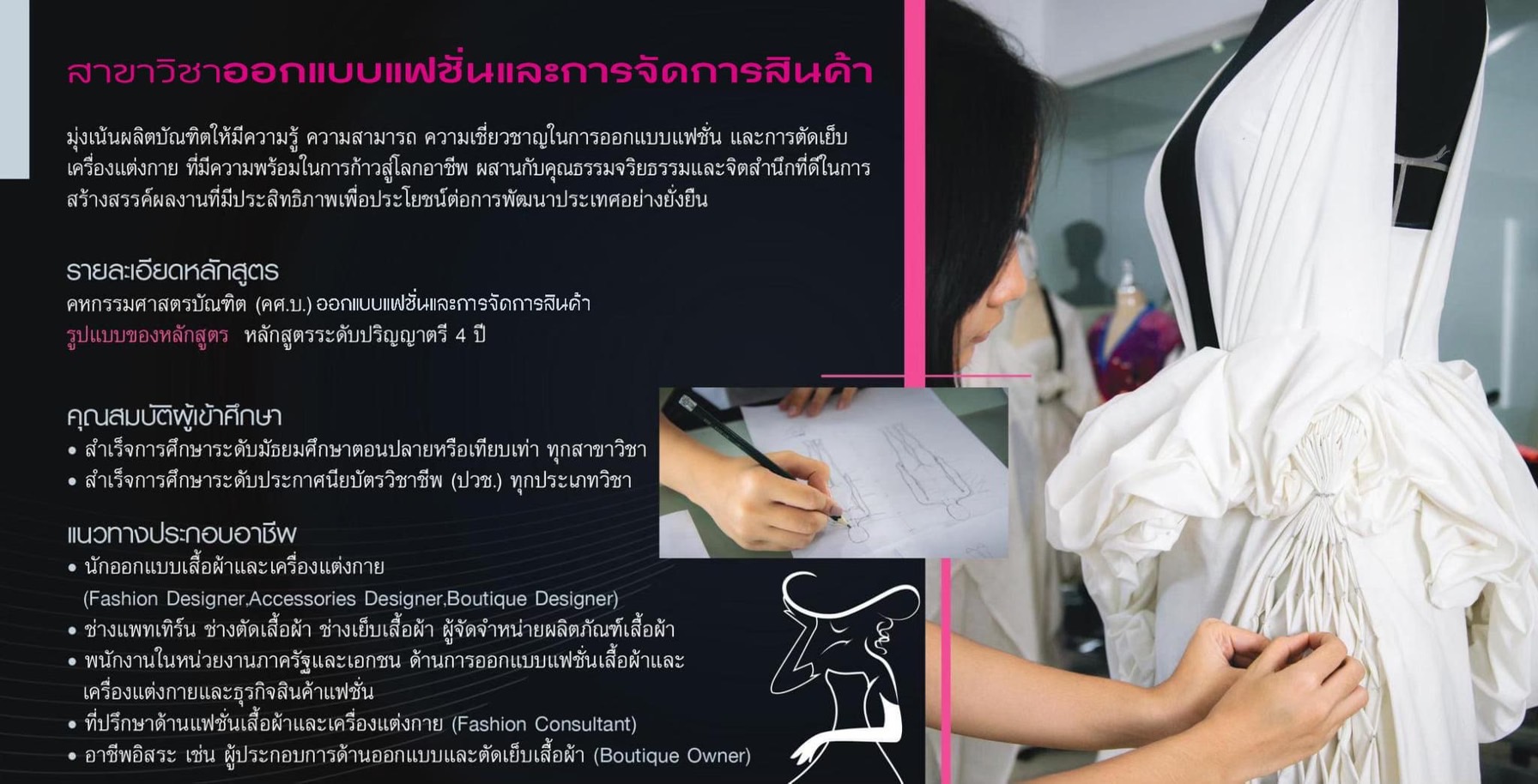Development Guidelines on Teaching and Learning Models for Fashion and Apparel Design Department, Faculty of Home Economics Technology, Rajamangala University of Technology Phra Nakhon
Main Article Content
Abstract
The aims were to compare the department of fashion and apparel design's teaching and learning outcomes and to find guidelines for the development of teaching and learning management styles in the department of fashion and apparel design. To gather feedback on teaching and learning satisfaction from current students enrolled in the 2020 academic year, lecturers in department, and alumni, a convenient random sampling of 104 people willing to participate in the online survey was used. Cronbach's alpha coefficient was 0.980, which was quite confident. Four external experts provide feedback on the training. The frequency, percentage, and mean were used to analyze the data. The results were summarized as follows: The majority of those who responded were alumni (50.96 %). The average degree of satisfaction on instructors was at its highest (mean 4.23). In the department of Fashion and Apparel Design, the average satisfaction with teaching and learning was compared. There was no variation in classification based on the respondents' status. A guideline for the development of teaching and learning management styles in the field of study by: (1) The curriculum, the name of the curriculum was adjustment and the addition of elective courses in the curriculum. (2) Instructors, adjust the use of team teaching. (3) Educational aid, to sign memorandum of understanding with the establishment. (4) Learning facilities, provide books that are relevant to the curriculum. And (5) other areas, adding publics relations channels, engaging alumni in collaborative, scholarship allocated, field trips and study tours.
Article Details
References
กีรติ ยศยิ่งยง. (2549). การวางแผนการพัฒนาทรัพยากรมนุษย์เชิงกลยุทธ์. มิสเตอร์ก๊อปปี้.
คณะเทคโนโลยีคหกรรมศาสตร์. (2560). เอกสารหลักสูตรคหกรรมศาสตรบัณฑิต สาขาวิชาออกแบบแฟชั่นผ้าและเครื่องแต่งกาย (หลักสูตรปรับปรุง พ.ศ. 2560). คณะเทคโนโลยีคหกรรมศาสตร์ มหาวิทยาลัยเทคโนโลยีราชมงคลพระนคร.
ณิรดา เวชญาลักษณ์. (2561). หลักการจัดการเรียนรู้. สำนักพิมพ์แห่งจุฬาลงกรณ์มหาวิทยาลัย.
ทิศนา แขมมณี. (2558). ศาสตร์การสอน : องค์ความรู้เพื่อการจัดกระบวนการเรียนรู้ที่มีประสิทธิภาพ (พิมพ์ครั้งที่ 19). สำนักพิมพ์แห่งจุฬาลงกรณ์มหาวิทยาลัย.
ประกาศกระทรวงศึกษาธิการ เรื่อง มาตรฐานคุณวุฒิระดับปริญญาตรี สาขาวิชาคหกรรมศาสตร์ พ.ศ. 2557. (6 มีนาคม 2558). ราชกิจจานุเบกษา. เล่ม 132 ตอนพิเศษ 52 ง.
พรธิดา วิเชียรปัญญา. (2547). การจัดการความรู้:พื้นฐานและการประยุกต์ใช้. เอ็กซเปอร์เน็ต.
มนตรี นามวงค์ และศุภวัฒนากร วงศ์ธนวสุ. (2560). การบริหารความสัมพันธ์กับศิษย์เก่าของสำนักงานศิษย์เก่าสัมพันธ์ มหาวิทยาลัยขอนแก่น. วารสารสงขลานครินทร์ ฉบับสังคมศาสตร์และมนุษย์ศาสตร์, 23(3), 159-178.
ยิ่งศักดิ์ เพชรนิล. (2558). รายงานการวิจัย เรื่อง ผลการประเมินความพึงพอใจของนักศึกษาและอาจารย์ต่อสิ่งสนับสนุนการเรียนรู้ สาขาวิชานิติศาสตร์ มหาวิทยาลัยราชภัฏเชียงราย ประจำปี 2558. มหาวิทยาลัยราชภัฏเชียงราย.
ราชบัณฑิตยสถาน. (2542). พจนานุกรมฉบับราชบัณฑิตยสถาน พ.ศ. 2542. นานมีบุ๊คส์พับลิเคชั่นส์.
เรณุมาศ มาอุ่น. (2559). การจัดการเรียนการสอนในระดับอุดมศึกษาอย่างมีประสิทธิภาพ. วารสารเทคโนโลยีภาคใต้, 9(2), 169-176.
วัลลภา เทพหัสดิน ณ อยุธยา. (2544). การพัฒนาการเรียนการสอนทางการอุดมศึกษา. โรงพิมพ์แห่งจุฬาลงกรณ์มหาวิทยาลัย.
ศุภกฤต พริ้วไธสง. (2561). การสำรวจความพึงพอใจของนักศึกษาต่อสิ่งสนับสนุนการเรียนรู้ วิชาการประยุกต์ใช้ไมโครโปรเซสเซอร์. วารสารวิชาการมหาวิทยาลัยธนบุรี, 12(27), 79-84.
สรชัย พิศาลยบุตร. (2549). สำรวจความพึงพอใจของผู้ใช้บริการ ทำได้ง่ายนิดเดียว. บริษัทวิทยพัฒน์ จำกัด.
สำนักงานคณะกรรมการการอุดมศึกษา. (2561). คู่มือการประกันคุณภาพการศึกษาภายใน ระดับอุดมศึกษา พ.ศ. 2557 (พิมพ์ครั้งที่ 5). ภาพพิมพ์.
สำนักวิชาการและประมวลผล มหาวิทยาลัยราชภัฏร้อยเอ็ด. (2556). คู่มือกระบวนการจัดการเรียนการสอนที่เน้นผู้เรียนเป็นสำคัญ (พ.ศ. 2556). มหาวิทยาลัยราชภัฏร้อยเอ็ด.
อธิมาตร เพิ่มพูน, วันชัย สุขตาม และจิรายุ ทรัพย์สิน. (2563). แนวทางส่งเสริมการมีส่วนร่วมในกิจกรรมของนักศึกษา มหาวิทยาลัยราชภัฏสุรินทร์. วารสารการบริหารการปกครองและนวัตกรรมท้องถิ่น, 4(1), 43-56.
Joyce, B. and Weil, M. (2003). Models of Teaching. 5th ed. Prentice-Hall of India Private Limited.
Research and Markets. (2022, February 3). Global Online Education Market (2022 to 2027) -by User-type, Provider, Technology and Region. https://www.globenewswire.com/en/news-release/2022/02/03/2378224/28124/en/Global-Online-Education-Market-2022-to-2027-by-User-type-Provider-Technology-and-Region.html

